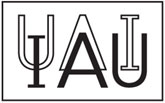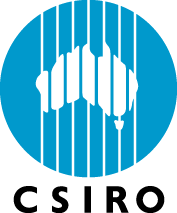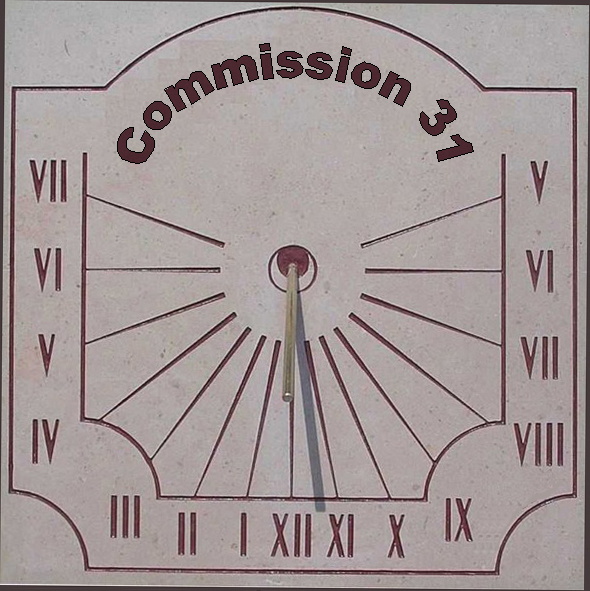JD 6 Time and Astronomy
Rio de Janeiro
Joint Discussion 6
Time and Astronomy
- I : Fundamental Astronomy
- X : Radio Astronomy
| Pascale Defraigne | (Belgium) | Chair | ||
| Aleksander Brzezinski | (Poland) | Co-Chair, President Com 19 | ||
| Richard Manchester | (Australia) | President Com 31 | ||
| Sergei Klioner | (Germany) | President Com 52 | ||
| Gambis Daniel | (France) | |||
| Rendong Nan | (China) | President Com 40 | ||
| Demetrios Matsakis | (US) | |||
| Michael Kramer | (UK) | |||
| Yury Ilyasov | (Russia) | |||
| Gerard Petit | (BIPM) |
- Pascale Defraigne
- Royal Observatory of Belgium
- Avenue Circulaire, 3
- B-1180 Brussels
- +32-2-373 02 60
- mail to P. Defraigne
- fax: +32-2-374 98 22
Responsibility for the definition of time scales left the astronomical community some 40 years ago when, in 1967, the second became defined by an atomic transition in the International System of units SI and when TAI was defined as the primary international time scale in 1971. Atomic time is now 107 times more stable than the Earth rotation and some 104 times more stable than the planetary orbital motions that were used to define time until 1967.
But time still interacts with astronomy in many ways: as the independent variable for the description of all dynamical systems, its stability allows one to study these systems and their perturbations. Time is therefore of major importance for astronomers, with time scales based on the SI second for practical applications and coordinate time scales for theoretical developments. Precise timing of the rotational and orbital periods of pulsars has the potential to contribute to the long-term stability of International Atomic Time (TAI), thereby returning some aspects of time keeping to astronomy. Furthermore, since observational techniques rely on the measurement of the time of propagation of electromagnetic signals, astronomy provides an important testing ground for relativity.
Although universal time is not used any more to provide the official time, it still reflects the Earth rotation and dictates the leap seconds and hence UTC, the international reference for time and frequency. The future of leap seconds is presently still a subject of debate led by the ITU-R Special Rapporteur Group. In parallel, the knowledge of UT1 is needed for any coordinate transformation between terrestrial and celestial reference systems. Together with the atomic time, UT1 serves precise orbit determination for both space research and Earth studies. The recent measurements of multiple space geodetic techniques, individually or in combination, provide high precision monitoring of LOD and UT1, and allow predictions as needed for real time applications. This improved accuracy on the UT1/LOD measurements also brings a new set of constraints for geophysical models.
The present realizations of the Terrestrial Time TT are the International Atomic Time TAI provided by the BIPM on a monthly basis, and TT(BIPM) based on the reprocessing using all primary frequency standard measurements. TT(BIPM) is presently the best reference to estimate the long-term stability of any other time scale, and in particular the long-term stability of pulsars. Thanks to the recent development of new frequency standards, and to the parallel progress in time scale algorithms and in time transfer techniques, the present atomic time scale stabilities and accuracies has been significantly improved.
Pulsars are incredibly stable clocks with a stability that rivals the best atomic clocks. Many pulsars are members of a binary system, enabling very precise measurement of the gravitational interactions between massive bodies and tests of gravitational theories. Such measurements have already given the most precise verification of Einstein's general relativity in the strong-field case. Future observations will reveal higher-order gravitational perturbations, providing even more stringent tests of gravitational theories. Recent developments of "pulsar timing arrays", in which a large sample of millisecond pulsars are regularly timed, have the potential to establish a time scale which is more stable than the best atomic timescales over long time intervals and hence to investigate the stability of these time scales.
They also are sensitive to errors or omissions in the planetary ephemeredes used to model the Earth's motion and hence to improve those ephemeredes. Finally, they have the potential to make a direct detection of gravitational waves from astronomical sources. Such measurements would open up a new window on the Universe and provide important constraints on models for the early Universe and galaxy evolution.

- UT1/LOD realization and accuracy
- Geophysical impact on UT1
- Short- and long-term variations of UT1
- Use of UT1 for astro-geodetic studies
- UT1 prediction
- Stability of TAI, TT(BIPM)
- Impact of new frequency standards on SI time scales
- GNSS time scales
- Time transfer
- Recent Developments with Leap Seconds
- Techniques of precision pulsar timing
- Pulsar time scales
- Pulsar tests of gravitational theories
- Pulsar Timing Arrays and detection of gravitational waves
- Improving solar-system ephemeredes
- Pulsar Timing Noise
The abstracts must be submitted before March 1st, 2009, via the website of the IAU General Assembly: http://www.astronomy2009.com.br/
sub-menu “Instructions for Presenters”
- C. Bizouard, D. Gambis : Earth rotation monitoring and connection to UTC
- R. Gross : Impact of Geophysical Fluids on UT1
- G. Petit : Atomic Time Scales and their Stability
- D. Matsakis : Algorithms for UTC and TT
- M. Kramer, I. Stairs : Binary pulsar tests of gravitational theories
- S. Kopeikin : Stability of pulsar rotational and orbital periods
| 9:00- 9:30 | Invited | D. Gambis, C. Bizouard | |
||||
| 9:30- 9:45 | V. Zharov | |
|||||
| 9:45-10:00 | S. Klioner | |
|||||
| 10:00-10:15 | J. Vondrak , C. Ron , V. Stefka | |
|||||
| 10:15-10:30 | N. Capitaine , P. Wallace | ||||||
| 11:00-11:30 | Invited | R. Gross | |||||
| 11:30-11:45 | S. Englich , H. Schuh , R. Weber | ||||||
| 11:45-12:00 | H. Schuh , J. Boehm , S. Englich , A. Nothnagel | |
|||||
| 12:00-12:15 | A. Brzezinski, N. Capitaine | |
|||||
| 12:15-12:30 | W. Wooden , B. Luzum , N. Stamatakos | |
|||||
| 14:00-14:15 | T. Fukushima | |
|||||
| 14:15-14:25 | D. D. McCarthy | |
|||||
| 14:25-15:30 | POSTER SESSION | ||||||
| 16:00-16:25 | Invited | G. Petit | |
||||
| 16:25-16:45 | Invited | D. Matsakis | |
||||
| 16:45-17:00 | P. Uhrich , P. Tuckey | |
|||||
| 17:00-17:15 | E.F. Arias , G. Panfilo | |
|||||
| 17:15-17:30 | H. Takiguchi , Y. Koyama , R. Ichikawa , T. Gotoh , A. Ishii , T. Hobiger , M. Hosokawa | |
|||||
| 9:00- 9:30 | Invited | S. Kopeikin | |
||||
| 9:30- 9:45 | J.O. Urama , A.E. Chukwude | Large glitches, small glitches and timing noise | |||||
| 9:45-10:00 | N. Wang | |
|||||
| 10:00-10:15 | A. Rodin | |
|||||
| 10:15-10:30 | M. Pshirkov | |
|||||
| 11:00-11:30 | Invited | M. Kramer | Binary pulsar tests of gravitational theories | ||||
| 11:30-11:45 | Y. Ilyasov , V. Zharov , M. Sekido | |
|||||
| 11:45-12:00 | R. Manchester | |
|||||
| 12:00-12:15 | V. Potapov , S. Kopeikin | |
|||||
Universal Time:
| Y. Barkin , J.M. Ferrandiz | Elliptical Chandler pole motions of the Earth and Mars | ||
| Y. Li | Inspection for Secular Variation of Earth's Rotation Inferred from Chinese Ancient Astronomical Records | ||
| C.L. Huang , Y. Liu | The difference of the Earth dynamical flattening (H) between precession observation and earth model can be reduced by $\frac{2}{3}$ | ||
| S. Kopeikin , Y. Xie | Post-Newtonian Reference Frames for Advanced Theory of the Lunar Motion and a New Generation of Lunar Laser Ranging | ||
| E. Pitjeva | High-accuracy numerical planet ephemerides EPM2008 and limitations on time variation of some astronomical constants | ||
| Y. Barkin | GreDeAks problem and solution of fundamental problems of celestial mechanics and geodynamics | ||
| R. Podestá , L. Weidong , E. Actis , et al. | Status and future of the cooperative San Juan SLR Station | ||
| M. Schindelegger , J. Boehm , S. Englich , H. Schuh | High-resolution Earth rotation parameters from the continuous VLBI campaign CONT08 | ||
| N. Glebova , G. Kosmodamianskiy , M.. Lukashova , I. Netsvetaev , G. Netsvetaeva , E. Parijskaja , M. Sveshnikov , V. Skripnichenko | Russian astronomical yearbooks in editions and program systems | ||
| H.J. Ma , Y.H. Hu , J.F. Wu , Z.M. He | Design and Analysis of Nanosecond Time Synchronization System of Each Station of Each Chain of Chinese LORAN-C | ||
| X. Yang , F. Wu , Z. Li | Two-Way Satellite Time and Frequency Transfer Experiment via IGSO Satellite | ||
| M. Hosokawa , K. Imamura , T. Iwama , S. Hama , J. Amagai , Y. Hanado , R. Ichikawa, Y. Koyama | Recent activities at NICT Space-Time Standards Group | ||
| J.F. Wu,Y.H. Hu, X.Lu, H.J. Ma, L. Hou, Z.M. He, J. Wang | Research on the technology of Common-view based on the Chinese Area Positioning System | ||
| H.J. Ma , Y.H. Hu , J.F. Wu , J.G. Wang , K. W. | Aircraft High Dynamic Two-Way Time Synchronization Technique research | ||
| X. Lu , F. Huang , H. Wu , Y. Bian | Studies on Algorithm of Autonomous Time Synchronization for Constellations | ||
| X. Li | Heterodyne Digital Method in Precision Frequency Measurement | ||
| T. Larchenkova | The precise timing of millisecond pulsars as a possible method of the study of globular clusters and Galaxy structures | ||
| R. Nan | Pulsar survey with the telescope FAST | ||
| O. Doroshenko | Pulsar Timing package TIMAPR upgrade | ||
| M. Sazhin | Pulsar timing as a tool for gravitational waves detection. | ||
| R. Shannon | A New Algorithm for Detecting Gravitational Waves Using Pulsars | ||
| A. Romanoff | Planetary ephemerides and pulsar timing | ||
| N. Korotkova, Y. Ilyasov, M. Pshirkov | Pulsar Time Scale study by ensembles of simulated models | ||
The instructions for presenters can be found on the IAU website : http://www.astronomy2009.com.br/instrpres.html
The proceedings will be published in
HIGHLIGHTS OF ASTRONOMY, Volume 15
Editor-in-Chief: Ian F Corbett
Publisher: Cambridge University Press (CUP, UK)
The proceedings must be written in Latex. You can find the author's style file as well as a number of sample and ‘readme’ files to create your paper, on the IAU website, at the following address: http://www.iau.org/static/scientific_meetings/authors_proceedings/
Your contribution should be send to p.defraigne@oma.be by email no later than the September 15, 2009, so that we can assemble all the papers and send the complete volume to the IAU in the deadline. As we receive only a maximum of 30 pages, only summaries can be proposed. These should be of 2 pages for invited talks and 1 page for oral contributions. There is unfortunately no possibility to include a paper for the poster presentations. All Authors are also requested to download the IAU Copyright Form from the IAU website, to complete it and to send it to Pascale Defraigne (see the contact info above), as the Editor of the JD. She will then send the complete set of IAU Copyright Forms, together with the complete manuscript of the JD Proceedings, to the IAU.



